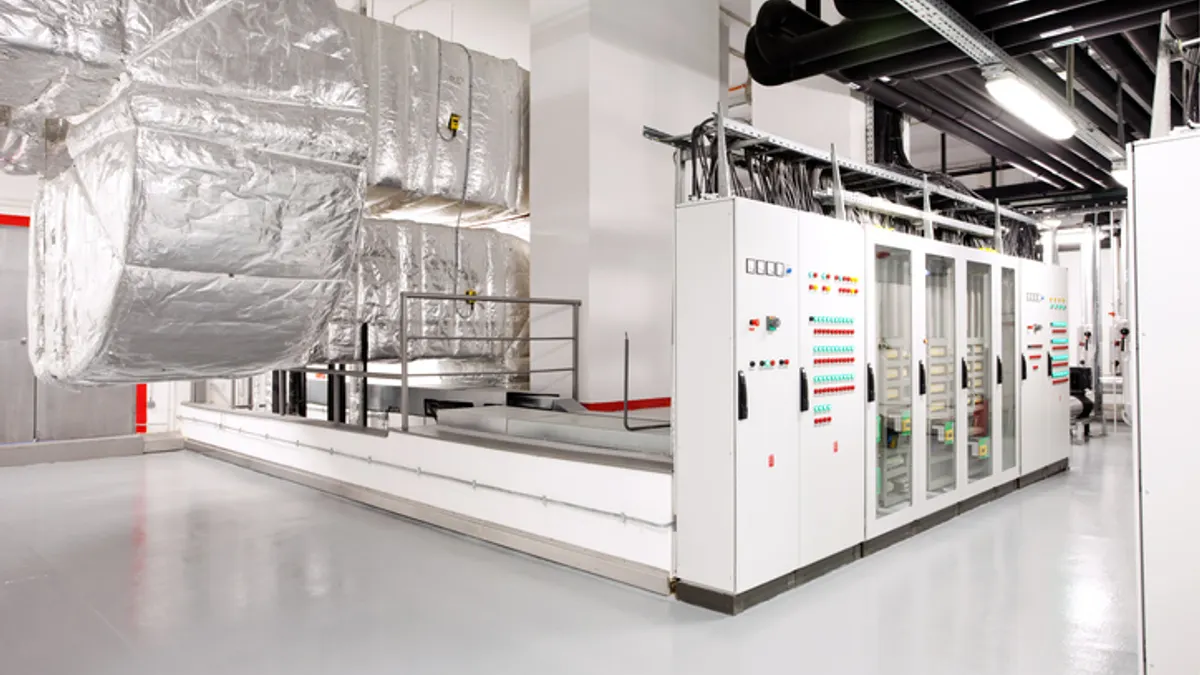Dive Brief:
- A U.S. Environmental Protection Agency and Efficient and Healthy Schools Program webinar Aug. 23 highlighed strategies facilities managers can use to improve ventilation, air disinfection and air flow to reduce the concentration of virus particles in the air.
- The webinar addressed guidance updates in May from the Centers for Disease Control and Prevention and the American Society of Heating, Refrigerating and Air-Conditioning Engineers in June.
- Speakers included Dr. Kenneth Mead, branch chief of the engineering and physical hazards branch at the CDC’s National Institute for Occupational Safety and Health, and William Bahnfleth, ASHRAE fellow and chair of Standard Project Committee 241, Control of Infectious Aerosols.
Dive Insight:
Key updates to CDC guidance include a definition of the term “ventilation” and recommendations of at least five air changes per hour in occupied spaces. Mead also pointed to updated minimum filter requirements and the need for an increased emphasis on system inspection, performance verification and code compliance as a “foundational starting point prior to invoking ventilation interventions.”
The previous guidance, which included both pre- and post-occupancy flushing, has been updated to include only post-occupancy flushing, Mead noted. “For nonresidential settings where an infectious source was not known to have been present, run the HVAC system for maximum outside airflow for two hours after occupancy,” he said.
He added that building operators should ensure that HVAC systems provide minimum outdoor air ventilation requirements in accordance with applicable design codes based on the year a building was constructed or the most recent renovation and the intended building occupancy.
When it comes to increasing filtration for buildings, multiple sources of incoming airflow can be created by opening windows and turning on exhaust fans, Mead suggested. He also noted turning thermostats to “on,” rather than “auto,” when rooms are occupied can prevent systems from diminishing ventilation in occupied rooms.
Bahnfleth, who previously served as president of ASHRAE, noted that schools come in a wide range of architectural styles, ages and HVAC systems, including those that have no mechanical ventilation. Their occupant density also varies from moderate to high. He said that due to high variability in their systems’ economic circumstances, facilities managers also have different levels of access to building and building system modifications.
Bahnfleth acknowledged that the process of predicting risk within one or two meters of an infected person is more complex than estimating risk based on the average air concentration in a room. While applying the ventilation standards, facilities managers must first conduct assessments to minimize the transmission risk of infectious diseases, he noted.
ASHRAE Standard 241 is dependent on equivalent clean airflow: the flow rate of pathogen-free air that, “if distributed uniformly within a breathing zone, would have the same effect on infectious aerosol concentration as the sum of actual outdoor airflow, filtered airflow, and inactivation of infectious aerosols,” according to slides Bahnfleth presented. Facilities managers must determine ECA for infection risk mitigation, determine total ECA for spaces and systems, and then analyze options to reach targets provided in the standard’s infection risk management mode, he said.
Bahnfleth added that by performing and documenting these assessments, operators can construct building readiness plans that can then serve as a reference for future use once these filtration strategies are implemented in a building.
On how to pay for upgrades, Bahnfleth pointed to federal and state-level funding as possible solutions, but he also noted that the recent ASHRAE standard was developed to be cost-effective.
“If you do the economic analysis on it, it pays for itself,” Bahnfleth said. “If the first thing you do … [is] to go back and do maintenance and have systems that work, you might save 15% on your energy bill, and that buys a lot of filter units.”
Mead said the CDC has been working to streamline its online guidance, and changes to its website now include more information on up-front maintenance and energy cost considerations for ventilation strategies. Additional changes include updated information on “do-it-yourself” air cleaners, discussions on whole-room ultraviolet germicidal irradiation and more concise answers to all other frequently asked questions.










